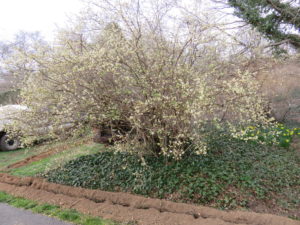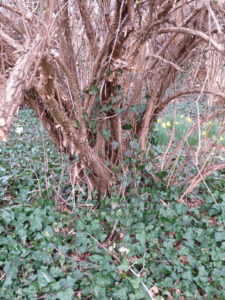Winter honeysuckle, aka fragrant honeysuckle (Lonicera fragrantissima) is a treasured heirloom shrub (USDA hardiness zones 4 to 8). Plantings of this late winter blooming large woody shrub are still found in historical (older) urban neighborhoods and city parks planted prior to the 1960’s.
This tough, durable shrub can reach 10+ feet tall and wide. You may opt to limb up its shaggy lower branches for show. The longevity of winter honeysuckle is incredible. If shrubs get out of control, cut the back to the ground after spring blooming is over. Vegetative cuttings root easily, and you can pass-along this old fashion shrub to gardening friends as it is rarely sold in garden centers.
Flowers are a harbinger of spring. Budded branches may be cut for an early, fragrant, indoor arrangement. In the southeastern U.S., small creamy flowers often emerge during a warm January – February spell. Winter honeysuckle continues to bloom on and off through March. Your nose will catch its sweet lemony fragrance. The deciduous blue green summer foliage offers no fall color. Further southern (zones 7 and 8), the foliage is almost evergreen.
Fragrant honeysuckle grows in average, dry to medium, well-drained soil, and in full sun to partial shade. This vigorous shrub asks for little care other that annual corrective pruning. Susceptible to a limited number of disease and pest issues, winter honeysuckle usually grows out it. Potential pests include aphids, scale, sawfly, whitefly, and webworm. Early native bees are especially glad to find it on winter days and are drawn to the pollen and nectar. If fruits (berries) are formed, hungry birds come and fest.
Yes, winter honeysuckle is a “true” honeysuckle and you should check whether if it is invasive in your state. It is not invasive in Tennessee and Virginia, but North Carolina and Texas forbids new plantings. Since it blooms so early in the year, e.g., compared to most honeysuckle species, few fruits (and seeds) form. In southern locales where winters are mild, it may seed-in prolifically.
Landscape use: clipped or informal hedge, screen or background border shrub.



 Posted in
Posted in 
